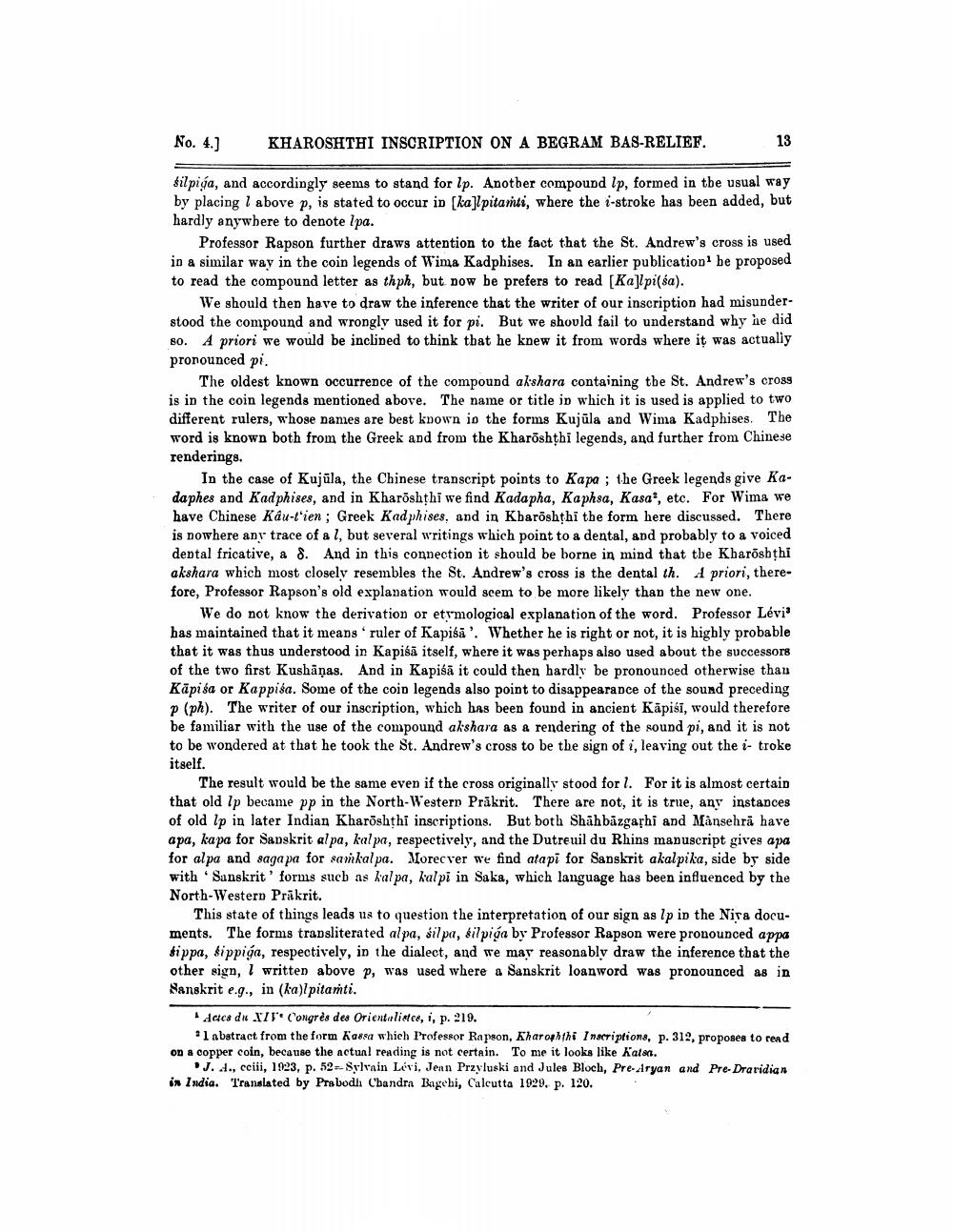________________
No. 4.]
KHAROSHTHI INSCRIPTION ON A BEGRAM BAS-RELIEF.
silpiga, and accordingly seems to stand for lp. Another compound lp, formed in the usual way by placing 1 above p, is stated to occur in [ka]lpitanti, where the i-stroke has been added, but hardly anywhere to denote lpa.
Professor Rapson further draws attention to the fact that the St. Andrew's cross is used in a similar way in the coin legends of Wima Kadphises. In an earlier publication be proposed to read the compound letter as thph, but now be prefers to read [Kallpi(sa).
We should then have to draw the inference that the writer of our inscription had misunderstood the compound and wrongly used it for pi. But we should fail to understand why he did 80. A priori we would be inclined to think that he knew it from words where it was actually pronounced pi.
The oldest known occurrence of the compound akshara containing the St. Andrew's cro89 is in the coin legends mentioned above. The name or title in which it is used is applied to two different rulers, whose names are best known io the forms Kujūla and Wima Kadphises. The word is known both from the Greek and from the Kharoshthi legends, and further from Chinese renderings.
In the case of Kujūla, the Chinese transcript points to Kapa ; the Greek legends give Kadaphes and Kadphises, and in Kharoshthi we find Kadapha, Kaphsa, Kasa?, etc. For Wima we have Chinese Kau-t'ien ; Greek Kadphises, and in Kbaroshthi the form here discussed. There is nowhere any trace of a l, but several writings which point to a dental, and probably to a voiced dental fricative, & 8. And in this connection it should be borne in mind that the Kharoshthi akshara which most closely resembles the St. Andrew's cross is the dental th. A priori, therefore, Professor Rapson's old explanation would seem to be more likely than the new one.
We do not know the derivation or etymological explanation of the word. Professor Lévi' has maintained that it means 'ruler of Kapiśā'. Whether he is right or not, it is higbly probable that it was thus understood in Kapiśā itself, where it was perhaps also used about the successors of the two first Kushāņas. And in Kapiśā it could then hardly be pronounced otherwise than Kāpisa or Kappisa. Some of the coin legends also point to disappearance of the sound preceding p (ph). The writer of our inscription, which has been found in ancient Kāpisi, would therefore be familiar with the use of the compound akshara as a rendering of the sound pi, and it is not to be wondered at that he took the St. Andrew's cross to be the sign of i, leaving out the i- troke itself.
The result would be the same even if the cross originally stood for l. For it is almost certain that old lp became pp in the North-Western Prākrit. There are not, it is true, any instances of old lp in later Indian Kharoshthi inscriptions. But both Shāhbāzgashi and Mansehrā have apa, kapa for Sanskrit al pa, kalpa, respectively, and the Dutreuil du Rhins manuscript gives apa for alpa and saga pa for sankalpa. Morec ver we find atapi for Sanskrit akalpika, side by side with Sanskrit forms sucb as kalpa, kalpi in Saka, which language has been influenced by the North-Western Prākrit.
This state of things leads us to question the interpretation of our sign as lp in the Niva documents. The forms transliterated alpa, silpa, silpiga by Professor Rapson were pronounced appa sippa, tippiga, respectively, in the dialect, and we may reasonably draw the inference that the other sign, I written above p, was used where a Sanskrit loanword was pronounced as in Sanskrit e.g., in (ka)lpitanti.
daes du site Congrès des Orientalistes, i, p. 219.
? 1 abstract from the form Kasea which I'rofessor Rapson, Kharophthi Inscriptions, p. 312, proposes to read on a copper coin, because the actual reading is not certain. To me it looks like Katea.
J. d., cciii, 1923, p. 52 - Sylvain Lévi, Jean Przyluski and Jules Bloch, Pre-Aryan and Pre-Dravidian in India. Translated by Prabodh Chandra Bagehi, Calcutta 1929. p. 120.




